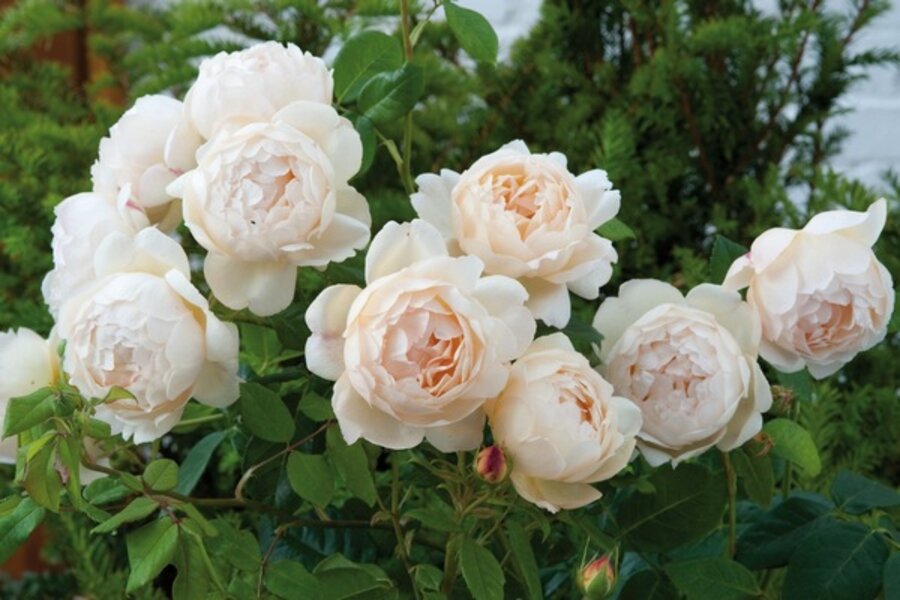New roses from David Austin for 2013
Loading...
When I’m giving a lecture on roses, I often begin by telling the audience my presentation could be hazardous to their health.
You see, I know better than most that once "rose fever" sets in, there is no cure. No matter how many roses one has, there will always be a more appealing one coming up in next year's gardening catalogs.
Which means rose fever can also be hazardous to the pocketbook.
I myself contracted a rare strain called English Rose fever while living in London in the early 1990s, when I fell in love with a new line of “old-fashioned” roses created by David Austin.
As a result of a hybridizing program initiated in the 1950s, he captured the appealing features of Old Garden Roses (roses introduced prior to 1867) such as cupped or rosette-shaped flowers and strong fragrance in bushes that have the repeat bloom and vigor of modern roses.
So before the new catalogs arrive, I am giving my pocketbook fair warning – I’ve had a sneak peek at the new US introductions, and they all look like keepers.
Years in the making
When I visited the David Austin nursery in Britain few years ago, I was able to take a tour of the entire operation. It was fascinating to see greenhouse after greenhouse filled with seedlings and cuttings in various stages of development.
Every year, 150,000 pollen crosses are made by hand, which will produce around 400,000 seeds. These seeds are planted after being chilled in a cooler for three months.
Approximately 250,000 of those seeds will germinate, and the resulting plants that grow from them are evaluated over a period of years for beauty, character, fragrance, diversity of bloom, disease resistance, and potential for use in flower arrangements. Nine years later, only four to six of the original 250,000 plants will make it into commerce.
Here is the class of 2013:
Wollerton Old Hall
This rose is going to be a must-have for me since I actually visited the 16th-century Hall House that is home to one of the most exquisite gardens in England.
Wollerton Old Hall has an intense myrrh fragrance and is said to be one of the most strongly scented of all English roses. The blooms are a soft cream with hints of peach [see photo above]. The bush has few thorns and produces an abundance of flowers over a long blooming season.
Lady Salisbury
Named to celebrate the 400th anniversary of Hatfield House, the home of Lady (and Lord) Salisbury in Hertfordshire, England, this new rose boasts Old World charm and makes an excellent cut flower. The sugary pink rosettes and matte green foliage are reminiscent of the Alba roses, but flower continuously until frost.
The Lady’s Blush
A perfect candidate for a mixed border, this Lady sports pure soft pink blossoms, a creamy white eye, and unusually attractive golden stamens.
Fighting Temeraire
A departure from most soft-colored English roses, this semi-double dazzler features rich apricot petals with a contrasting splash of yellow behind the stamens. It produces masses of flowers on strong stems and can be trained as a climber
Named after an 1839 painting by JMW Turner, this colorful English rose has won awards for fragrance and as a landscape rose. Its scent is described as “very fruity with a strong element of lemon zest.”
Queen Anne
The medium-sized flowers of Queen Anne are a pretty rose pink with outer petals slightly paler than interior ones. The flowers are fragrant and stems are virtually thornless.
England’s Rose
This is another must-have for me. The flowers of England's Rose are cerise pink with a spicy fragrance. It throws out large clusters of blooms from May through October or November. And best of all, it is weather resistant! Even with periods of heavy rain, the blooms will not ball, and petals drop cleanly. Yippee! No more soggy blossoms that look like dead mice!
One word of caution: I understand that the blooms may be small in areas that are quite hot.
So there you go. Six new roses to tempt us. My problem is I want them all, but sometimes it just isn't possible. Since my mountain garden is smaller than the old one in Maryland, I have to consider available space. And then there is that pesky pocketbook!
I've had several people ask me which one to choose if you can have only one. So I consulted the expert, Michael Marriott, technical manager for David Austin. He suggests Wollerton Old Hall for its fragrance, beauty, and vigor. In addition, it can be grown as a shrub or climber.
I actually need a climber by my front porch, which makes Wollerton a no-brainer for me.
Plus, every time I see it in bloom I'll be reminded of that splendid day in that splendid garden in England.
PSSST: I’ve ordered two Wollerton Old Hall bushes that will grow on either side of the climbing rose Night Owl. The combination of cream and purple should be a traffic-stopper.
-----
Lynn Hunt, the Rose Whisperer, is one of more than a dozen expert gardeners who blog regularly at Diggin' It. She's an accredited horticultural judge and a Consulting Rosarian Emeritus for the American Rose Society. She has won dozens of awards for her writing in newspapers, magazines, and television. After a recent move, she grows roses and other plants in her garden in the mountains of western North Carolina.. To read more by Lynn here at the Monitor, click here.You can also follow her on Twitter and read her Dirt Diaries.







